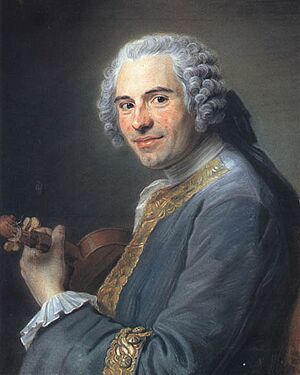Jean-Joseph de Mondonville facts for kids

Jean-Joseph de Mondonville (born December 25, 1711, died October 8, 1772) was a talented French violinist and composer. He lived at the same time as another famous composer, Jean-Philippe Rameau. Mondonville was very successful during his lifetime. A writer named Pierre-Louis Daquin once said, "If I couldn't be Rameau, there's no one I would rather be than Mondonville."
Contents
Life of a Musician
Mondonville was born in Narbonne, a city in the south of France. His family was noble but had lost much of its wealth.
In 1733, he moved to Paris. There, he gained the support of the king's mistress, Madame de Pompadour. This helped him get important musical jobs. He became a violinist for the Concert Spirituel, which was a famous series of public concerts.
His first published music was a collection of violin sonatas in 1733. He also became a violinist for the Chapelle royale (Royal Chapel) and performed in many concerts. Some of his large religious songs, called grands motets, were also performed and became very popular.
Mondonville continued to rise in his career. In 1740, he became a "sous-maître" (assistant master) and in 1744, an "intendant" (director) of the Royal Chapel. He wrote operas for the Opéra and grands motets for the Concert Spirituel. He also worked with the Théatre des Petits-Cabinets. All this time, he kept playing the violin throughout the 1740s.
In 1755, he became the director of the Concert Spirituel after Pancrace Royer passed away. Mondonville died in Belleville, near Paris, when he was sixty years old.
Mondonville's Music
Sacred Music
Between 1734 and 1755, Mondonville wrote 17 grands motets, which are large religious pieces for choir and orchestra. Only nine of these have survived. One of his motets, Venite exultemus domino, helped him get the job of "Master of Music of the Chapel" in 1740.
Mondonville was very skilled at writing for both instruments and voices. He brought a new level of excitement and drama to the grand motet. This type of music was very important in the Royal Chapel before the French Revolution. In 1758, he also introduced oratorios, which are large musical works usually based on religious stories, to the Concert Spirituel.
Operas
Mondonville's first opera, Isbé, was not very successful. However, he had great success with lighter types of French Baroque opera. These included the opéra-ballet (an opera with a lot of dancing) and the pastorale héroïque (a heroic story set in a peaceful countryside).
His most popular works were Le carnaval de Parnasse, Titon et l'Aurore, and Daphnis et Alcimadure. For Daphnis et Alcimadure, he even wrote the story himself in Languedocien, which was his local language.
Titon et l'Aurore played an important part in the "Querelle des Bouffons." This was a big argument in Paris in the early 1750s. It was about whether French opera or Italian opera was better. Supporters of French opera made sure that Titon's first show was a huge success. Some even said they filled the theater with royal soldiers to guarantee it!
Mondonville tried to write a serious French opera, called a tragédie en musique, but it was not successful. He tried something unusual: he used the same story, Thésée, that Jean-Baptiste Lully had used in 1675. Lully was known as the "father of French opera." Mondonville's bold choice to replace Lully's beloved music with his own did not work out well. The first performance in 1765 had mixed reactions. A public show two years later ended with the audience demanding that Lully's original version be played instead.
However, Mondonville was actually ahead of his time. In the 1770s, it became popular to set Lully's tragedy stories to new music. A famous example of this was Armide by Gluck.
Selected Works
Instrumental Music
- Sonatas for violin, Op. 1 (1733)
- 6 Trio Sonatas for two violins with continuo, Op. 2 (1734)
- 6 Harpsichord pieces in sonata form, Op. 3 (1734, later arranged for orchestra in 1749)
- The introduction to Op. 4 (1738) was the first written guide on how to play "harmonic sounds" on the violin.
- Harpsichord pieces with voice or violin, Op. 5 (1748)
Operas
- Isbé (1742)
- Bacchus et Erigone (1747)
- Le carnaval du Parnasse (1749)
- Vénus et Adonis (1752)
- Titon et l'Aurore (1753)
- Daphnis et Alcimadure (1754)
- Les fêtes de Paphos (1758)
- Thésée (1765)
- Les projets de l'Amour (1771)
Grands Motets
Mondonville's nine surviving grands motets are:
- Dominus regnavit decorem (Psalm 92) (1734)
- Jubilate Deo (Psalm 100) (1734)
- Magnus Dominus (Psalm 48) (1734)
- Cantate domino (Psalm 150) (1743)
- Venite exultemus Domino (Psalm 95) (1743)
- Nisi Dominus aedficavit (Psalm 127) (1743)
- De profundis (Psalm 130) (1748)
- Coeli enarrant gloriam Dei (Psalm 19) (1750)
- In exitu Israel (Psalm 115) (1753)
Oratorios
Mondonville wrote three oratorios, but none of them have survived:
- Les Israélites à la Montagne d'Oreb (1758)
- Les Fureurs de Saul (1759)
- Les Titans (1761)
See also
 In Spanish: Jean-Joseph de Mondonville para niños
In Spanish: Jean-Joseph de Mondonville para niños


